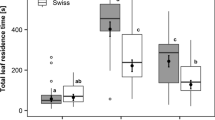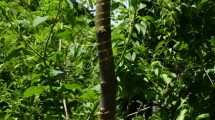Abstract
Phytoseiulus macropilis Banks (Acari: Phytoseiidae) is a specialist predator of the two-spotted spider mite Tetranychus urticae Koch (Acari: Tetranychidae), and has been used to control the pest in its native range: Mediterranean regions, the tropics and Florida, USA. This study investigates the thermal biology as a proxy for establishment potential of glasshouse escapees in cooler northern European climates, using a combination of laboratory and field trials. High mortality rates at 10 °C indicated limited acclimation ability. Mites displayed continuous oviposition in conditions that have previously been shown to induce a hiatus in other phytoseiid species, supporting previous findings that Phytoseiulus is a genus with no diapause state. Adult P. macropilis supercooled to between −17.2 and −24.0 °C, but the lower lethal temperature50 was −5.7 °C, resulting in a high level of pre-freeze mortality. The lethal time50 at 5 °C was 2.6 days, and maximum survival in winter field trials across 2010 and 2011 was 21 days. The thermal biology data indicate that P. macropilis is unlikely to establish in northern Europe, and will therefore make a suitable glasshouse biological control agent in temperate climates.





Similar content being viewed by others
References
Ali F (1998) Life tables of Phytoseiulus macropilis (Banks) (Gamasida: Phytoseiidae) at different temperatures. Exp Appl Acarol 22:335–342
Allen C (2010) Thermal biology and behaviour of two predatory phytoseiid mites: Amblyseius swirskii and Phytoseiulus longipes. Thesis (PhD), University of Birmingham, UK
Bale JS (1993) Classes of insect cold hardiness. Funct Ecol 7:751–753
Bale JS (2011) Harmonisation of regulations for invertebrate biocontrol agents in Europe: progress, problems and solutions. J Appl Entomol 135:503–513
Bale JS, O’Doherty R, Atkinson HJ, Stevenson RA (1984) An automatic thermoelectric cooling method and computer-based recording system for super cooling point studies on small invertebrates. Cryobiology 21:340–347
Bale JS, van Lenteren JC, Bigler F (2008) Biological control and sustainable food production. Philos Trans R Soc B 363:761–776
Beckett SJ, Evans DE (1997) The effects of thermal acclimation on immature mortality in the Queensland fruit fly Bactrocera tryoni and the light brown apple moth Epiphyas postvittana at a lethal temperature. Entomol Exp Appl 82:45–51
Bigler F, Loomans A, van Lenteren JC (2005) Harmonisation of the regulation of invertebrate biological control agents in Europe. In: Proceedings of the second international symposium on biological control of arthropods, Davos, Switzerland, 12–16 September 2005. USDA Forest Service, USA, pp 692–700
Broufas GD, Pappas ML, Koveos DS (2006) Effect of cold exposure and photoperiod on diapause termination of the predatory mite Euseius finlandicus (Acari: Phytoseiidae). Environ Entomol 35:1216–1221
Carvalho FP (2006) Agriculture, pesticides, food security and food safety. Environ Sci Policy 9:685–692
Cock MJW, van Lenteren JC, Brodeur J, Barratt BIP, Bigler F, Bolckmans K, Cônsoli FL, Haas F, Mason PG, Parra JRP (2010) Do new access and benefit sharing procedures under the Convention of Biological Diversity threaten the future of biodiversity? BioControl 55:199–218
Coombs MR, Bale JS (2013) Comparison of thermal activity thresholds of the spider mite predators Phytoseiulus macropilis and Phytoseiulus persimilis (Acari: Phytoseiidae). Exp Appl Acarol 59:435–445
Criddle RS, Smith BN, Hansen LD (1997) A respiration based description of plant growth rate responses to temperature. Planta 201:441–445
Denoth M, Frid L, Myers JH (2002) Multiple agents in biological control: improving the odds? Biol Control 24:20–30
Driestadt SH, Clark JK, Flint ML (2004) Pests of landscape trees and shrubs: an integrated pest management guide. University of California, Oakland, USA
Ferragut F, Garcia-Marí F, Costa-Comelles J, Laborda R (1987) Influence of food and temperature on development and oviposition of Euseius stipulatus and Typhlodromus phialatus (Acari: Phytoseiidae). Exp Appl Acarol 3:317–329
Ferrero M, Gigot C, Tixier M-S, van Houten YM, Kreiter S (2010) Egg hatching response to a range of air humidities for six species of predatory mites. Entomol Exp Appl 135:237–244
Finney DJ (1971) Probit analysis. University Press, Cambridge, UK
Fitzgerald JD, Solomon MG (1991) Diapause induction and duration in the phytoseiid mite Typhlodromus pyri. Exp Appl Acarol 12:135–145
Hart AJ, Tullett AG, Bale JS, Walters KFA (2002a) Effects of temperature on the establishment potential in the UK of the non-native glasshouse biocontrol agent Macrolophus calignosus. Physiol Entomol 27:112–123
Hart AJ, Bale JS, Tullett AG, Worland MR, Walters KFA (2002b) Effects of temperature on the establishment potential of the predatory mite Amblyseius californicus McGregor (Acari: Phytoseiidae) in the UK. J Insect Physiol 48:593–599
Hatherly IS, Bale JS, Walters KFA, Worland MR (2004) Thermal biology of Typhlodromips montdorensis: implications for its introduction as a glasshouse biological control agent in the UK. Entomol Exp Appl 111:97–109
Hatherly IS, Hart AJ, Tullett AG, Bale JS (2005a) Use of thermal data as a screen for the establishment potential of non-native biological control agents in the UK. BioControl 50:687–698
Hatherly IS, Bale JS, Walters KFA (2005b) UK winter egg survival in the field and laboratory diapause of Typhlodromips montdorensis. Physiol Entomol 30:87–91
Hatherly IS, Pedersen BP, Bale JS (2008) Establishment potential of the predatory mirid Dicyphus Hesperus in northern Europe. BioControl 53:589–601
Hoy MA (1975) Effect of temperature and photoperiod on the induction of diapause in the mite Metaseiulus occidentalis. J Insect Physiol 21:605–611
Hughes GE, Bale JS, Sterk G (2009) Thermal biology and establishment potential in temperate climates of the predatory mirid Nesidiocoris tenuis. BioControl 54:785–795
Hunt EJ, Kuhlmann U, Sheppard A, Qin T-K, Barratt BIP, Harrison L, Mason PG, Parker D, Flanders RV, Goolsby J (2008) Review of invertebrate biological control agent regulation in Australia, New Zealand, Canada and the USA: recommendations for a harmonised European system. J Appl Entomol 132:89–123
Jolly RL (2000) The predatory mite Neoseiulus californicus: its potential as a biocontrol agent for the fruit tree red spider mite Paronychus ulmi in the UK. In: Proceedings of 2000 Brighton Conference—pests and diseases, vol 1, pp 487–490
Klok CJ, Chown SL (2003) Resistance to temperature extremes in sub-Antarctic weevils: interspecific variation, population differentiation and acclimation. Biol J Linn Soc 73:401–414
Koštál V, Vambera J, Bastl J (2004) On the nature of pre-freeze mortality in insects: water balance, ion homeostasis and energy charge in the adults of Pyrrhocoris apterus. J Exp Biol 207:1509–1521
Koštál V, Renault D, Mehrabianova A, Bastl J (2007) Insect cold tolerance and repair of chill-injury at fluctuating thermal regimes: role of ion homeostasis. Comp Biochem Physiol A 147:231–238
Loomans AJM (2007) Regulation of invertebrate Biological Control Agents in Europe: review and recommendations in its pursuit of harmonised regulatory system. Report EU project REBECA [Regulation of Biological Control Agents]
Luczynski A, Nyrop JP, Shi A (2007) Influence of cold storage on pupal development and mortality during storage and on post-storage performance of Encarsia formosa and Eretmocerus eremicus (Hymenoptera: Aphelinidae). Biol Control 40:107–117
Miller A, Armitage AM (2002) Temperature, irradiance, photoperiod, and growth retardants influence greenhouse production of Angelonia angustifolia Benth. Angel Mist series. HortScience 37:319–321
Moraes GJ, McMurtry JA, Denmark HA, Campos CB (2004) A revised catalogue of the mite family Phytoseiidae. Zootaxa 1:434–494
Morewood WD (1993) Diapause and cold hardiness of phytoseiid mites (Acarina: Phytoseiidae). Eur J Entomol 90:3–10
Oliveira H, Janssen A, Pallini A, Venzon M, Fadini M, Duarte V (2007) A phytoseiid predator from the tropics as potential biological control agent for the spider mite Tetranychus urticae Koch (Acari: Tetranychidae). Biol Control 42:105–109
Oliveira H, Fadini MAM, Venzon M, Rezende D, Rezende F, Pallini A (2008) Evaluation of the predatory mite Phytoseiulus macropilis Banks (Acari: Phytoseiidae) as a biological control agent of the two-spotted spider mite on strawberry plants under greenhouse conditions. Exp Appl Acarol 47:275–283
Pilkington LJ, Messelink G, van Lenteren JC, Le Mottee K (2010) “Protected biological control”—biological pest management in the greenhouse industry. Biol Control 52:216–220
Raak-van den Berg CL, Stam JM, de Jong PW, Hemerik L, van Lenteren JC (2012) Winter survival of Harmonia axyridis in the Netherlands. Biol Control 60:68–76
Rock GC, Yeargan DR, Rabb RL (1971) Diapause in the phytoseiid mite, Neoseiulus (T.) fallacis. J Insect Physiol 17:1651–1659
Roy M, Brodeur J, Cloutier C (2003) Effect of temperature on intrinsic rates of natural increase (rm) of a coccinellid and its spider mite prey. BioControl 48:57–72
Saba F (1974) Life history and population dynamics of Tetranychus tumidus in Florida (Acarina: Tetranychidae). Fla Entomol 57:47–63
Sømme L (1999) The physiology of cold hardiness in terrestrial arthropods. Eur J Entomol 96:1–10
Tullett AG (2002) Methodologies for assessing the effects of low temperature on the establishment potential of non-native arthropods. PhD Thesis, University of Birmingham, UK
Tullett AG, Hart AJ, Worland MR, Bale JS (2004) Assessing the effects of low temperature on the establishment potential in Britain of the non-native biological control agent Eretmocerus eremicus. Physiol Entomol 29:363–371
van Lenteren JC (2000) A greenhouse without pesticides: fact or fantasy? Crop Prot 19:375–384
van Lenteren JC, Bueno VHP (2003) Augmentative biological control of arthropods in Latin America. BioControl 48:123–139
van Lenteren JC, Babendreier D, Bigler F, Burgio G, Hokkanen HMT, Kuske S, Loomans AJM, Menzler-Hokkanen I, van Rijn PCJ, Thomas MB, Tommasini MG, Zeng QQ (2003) Environmental risk assessment of exotic natural species used in inundative biological control. BioControl 48:3–38
van Lenteren JC, Bale J, Bigler F, Hokkanen HMT, Loomans AJM (2006) Assessing risks of releasing exotic biological control agents of arthropod pests. Annu Rev Entomol 51:609–634
Veerman A (1992) Diapause in phytoseiid mites: a review. Exp Appl Acarol 14:1–60
Williams F, Eschen R, Harris A, Djeddour D, Pratt C, Shaw RS, Varia S, Lamontagne-Godwin J, Thomas SE, Murphy ST (2010) The economic cost of invasive non-native species on Great Britain. CABI, UK. NNSS: https://secure.fera.defra.gov.uk/nonnativespecies/index.cfm?sectionid=59. Cited 4 Oct 2013
Wilson C, Tisdell C (2001) Analysis: why farmers continue to use pesticides despite environmental, health and sustainability costs. Ecol Econ 39:449–462
Acknowledgments
Megan Coombs was funded by the Biotechnology and Biological Sciences Research Council (BBSRC) in a CASE studentship with Biobest Belgium. Many thanks go to Dr. Yves Arijs (Biobest) for support and supply of mites.
Author information
Authors and Affiliations
Corresponding author
Additional information
Handling Editor: Patrick De Clercq.
Rights and permissions
About this article
Cite this article
Coombs, M.R., Bale, J.S. Thermal biology of the spider mite predator Phytoseiulus macropilis . BioControl 59, 205–217 (2014). https://doi.org/10.1007/s10526-014-9559-x
Received:
Accepted:
Published:
Issue Date:
DOI: https://doi.org/10.1007/s10526-014-9559-x




